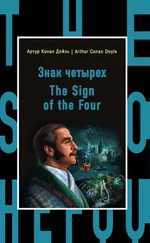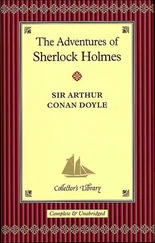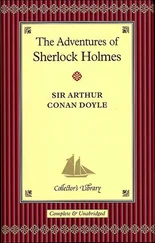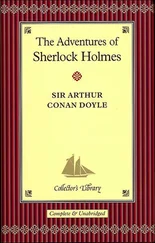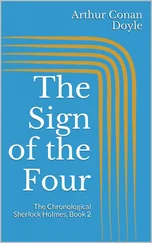THE SIGN OF THE FOUR
Arthur Conan Doyle
Copyright Copyright History of Collins Life & Times Chapter 1 Chapter 2 Chapter 3 Chapter 4 Chapter 5 Chapter 6 Chapter 7 Chapter 8 Chapter 9 Chapter 10 Chapter 11 Chapter 12 Classic Literature: Words and Phrases About the Publisher
William Collins
An imprint of HarperCollins Publishers
1 London Bridge Street
London SE1 9GF
WilliamCollinsBooks.com
This eBook published by William Collins in 2015
Life & Times section © HarperCollins Publishers Ltd
Gerard Cheshire asserts his moral right as author of the Life & Times section
Classic Literature: Words and Phrases adapted from
Collins English Dictionary
Cover by e-Digital Design. Cover image: Cover illustration by Abbey, 1949 edition © Mary Evans Picture Library
A catalogue record for this book is available from the British Library
All rights reserved under International and Pan-American Copyright Conventions. By payment of the required fees, you have been granted the non-exclusive, non-transferable right to access and read the text of this e-book on-screen. No part of this text may be reproduced, transmitted, down-loaded, decompiled, reverse engineered, or stored in or introduced into any information storage and retrieval system, in any form or by any means, whether electronic or mechanical, now known or hereinafter invented, without the express written permission of HarperCollins.
Source ISBN: 9780008110468
Ebook Edition © January 2015 ISBN: 9780008110475
Version: 2014-12-18
History of Collins History of Collins Life & Times Chapter 1 Chapter 2 Chapter 3 Chapter 4 Chapter 5 Chapter 6 Chapter 7 Chapter 8 Chapter 9 Chapter 10 Chapter 11 Chapter 12 Classic Literature: Words and Phrases About the Publisher
In 1819, millworker William Collins from Glasgow, Scotland, set up a company for printing and publishing pamphlets, sermons, hymn books, and prayer books. That company was Collins and was to mark the birth of HarperCollins Publishers as we know it today. The long tradition of Collins dictionary publishing can be traced back to the first dictionary William published in 1824, Greek and English Lexicon . Indeed, from 1840 onwards, he began to produce illustrated dictionaries and even obtained a licence to print and publish the Bible.
Soon after, William published the first Collins novel, Ready Reckoner ; however, it was the time of the Long Depression, where harvests were poor, prices were high, potato crops had failed, and violence was erupting in Europe. As a result, many factories across the country were forced to close down and William chose to retire in 1846, partly due to the hardships he was facing.
Aged 30, William’s son, William II, took over the business. A keen humanitarian with a warm heart and a generous spirit, William II was truly “Victorian” in his outlook. He introduced new, up-to-date steam presses and published affordable editions of Shakespeare’s works and The Pilgrim’s Progress , making them available to the masses for the first time. A new demand for educational books meant that success came with the publication of travel books, scientific books, encyclopedias, and dictionaries. This demand to be educated led to the later publication of atlases, and Collins also held the monopoly on scripture writing at the time.
In the 1860s Collins began to expand and diversify and the idea of “books for the millions” was developed. Affordable editions of classical literature were published, and in 1903 Collins introduced 10 titles in their Collins Handy Illustrated Pocket Novels. These proved so popular that a few years later this had increased to an output of 50 volumes, selling nearly half a million in their year of publication. In the same year, The Everyman’s Library was also instituted, with the idea of publishing an affordable library of the most important classical works, biographies, religious and philosophical treatments, plays, poems, travel, and adventure. This series eclipsed all competition at the time, and the introduction of paperback books in the 1950s helped to open that market and marked a high point in the industry.
HarperCollins is and has always been a champion of the classics, and the current Collins Classics series follows in this tradition – publishing classical literature that is affordable and available to all. Beautifully packaged, highly collectible, and intended to be reread and enjoyed at every opportunity.
Life & Times Life & Times Chapter 1 Chapter 2 Chapter 3 Chapter 4 Chapter 5 Chapter 6 Chapter 7 Chapter 8 Chapter 9 Chapter 10 Chapter 11 Chapter 12 Classic Literature: Words and Phrases About the Publisher
About the Author
Arthur Conan Doyle was born in Edinburgh, Scotland, in 1859, the year Charles Darwin’s The Origin of Species was published. Conan Doyle was raised Catholic but declared himself agnostic by the time he began reading medicine at Edinburgh University, in 1876. He attained his doctorate in 1885, researching a condition caused by syphilis, known as tabes dorsalis , and characterised by the degeneration of sensory neurons causing the body to malfunction.
Conan Doyle’s professional life began with a stint as ship’s doctor on a voyage around the coast of west Africa. In early 1882, before his doctorate was complete, he set up a surgery in Plymouth, England, with a university friend. Unfortunately, their professional relationship was short-lived and Conan Doyle moved to Southsea, England, by that summer. He then established his own medical practice, but found that business was slow, so he worked on his writing, which he had enjoyed from an early age. By 1887, he had published his first Sherlock Holmes novel and steered his career in a different direction.
Between 1887 and 1927, Conan Doyle published nine Sherlock Holmes books: four novels and five collections of short stories. He wrote many other books, but Sherlock Holmes became such an iconic character that his other works were rather overshadowed. In fact, Conan Doyle made the decision to kill off Sherlock Holmes in 1894, in a short story entitled The Final Problem . There was such public outcry at the death of Sherlock Holmes that Conan Doyle was moved to bring him back to life in The Return of Sherlock Holmes .
Despite his agnosticism, Conan Doyle developed an interest in spiritualism, becoming fascinated by beliefs in supernatural phenomena, including the Cottingley Fairy photographs, now understood to be hoaxes. His obsession also created a rift between himself and his friend, escapologist Harry Houdini. Conan Doyle couldn’t accept that Houdini’s escapades were elaborate tricks and Houdini grew vexed at Conan Doyle’s insistence that he possessed magical powers.
Conan Doyle suffered from considerable personal tragedy in the early years of the 20th century. A number of family members died, including his wife Louise, in 1906, and his son Kingsley, in 1918. There was also the horror of World War I to contend with, which affected the entire nation’s morale.
One of Conan Doyle’s better-known other works is the science-fiction novel The Lost World , published in 1912. The character Professor Challenger mounts an expedition to the Amazon Basin. He and his entourage encounter all manner of prehistoric animals along the way and witness warfare between an indigenous tribe and ape-men. In context, this novel can be seen as a document of scientific inquiry at the time. The French science-fiction author Jules Verne had died six years before, leaving an anthology of similar stories, including Journey to the Centre of the Earth , 1864. Similarly, Conan Doyle’s contemporary, the English writer H. G. Wells, had published The Time Machine in 1895. These books all enabled the characters to visit other places in time and to witness extinct creatures brought back to life. This general theme proved popular in an era when fossils and the processes of evolution were beginning to be understood by science. Conan Doyle used science to underpin his literature, although it is fair to say that he allowed pseudoscience to also appear towards the end of his life. Sherlock Holmes was Conan Doyle’s expression of his recognition that the application of empirical science and acute intellect were the things that members of the British Empire saw as the reason for their success.
Читать дальше


